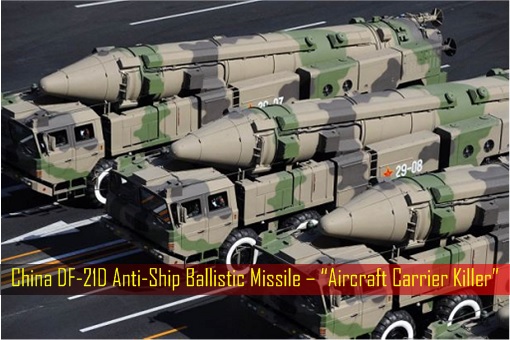Back in 2015, President Xi Jinping said that China has no intention of militarizing man-made structures in the South China Sea near the Spratly Islands. He assured then-president Barack Obama that the reclaimed islands were not for military purpose. However, the Chinese continue enhancing and equipping man-made islands like Mischief Reef, Subi Reef and Firey Cross Reef.
Of course, Washington knew Beijing was lying and China knew the U.S. knew they were lying. There was absolutely nothing that the military superpower can do to stop the Chinese from making fortresses in the region. China continues to claim the rights to most of the strategic waterway and has equipped the man-made outposts with airstrips, radar domes and missile systems.
In what appears to be a slap in the face to President Donald Trump, who was in Osaka, Japan, attending the G-20 Summit, China launched multiple anti-ship ballistic missiles over the weekend. Calling the Chinese missile test “disturbing”, the Pentagon has described Beijing’s actions as “meant to intimidate” – obviously referring to the U.S.’ “freedom of navigation” missions in the region.

At the G-20 Summit, Trump has agreed to not only a trade war ceasefire, a “temporary timeout” where the president holds back new tariffs on a further US$350 billion in imports from China, but also extends lifeline to Huawei. American companies were allowed again to sell products to the Chinese tech giant. He made the concessions knowing well China was about to test their anti-ship missiles.
Pentagon spokesman Lieutenant Colonel Dave Eastburn said – “Of course the Pentagon was aware of the Chinese missile launch from the man-made structures in the South China Sea near the Spratly Islands.” In truth, ahead of the exercise, Beijing warned other ships not to enter a designated area between the Spratly and Paracel Islands for five days.
The Pentagon did not specify the type of missile fired by the Chinese, but observers and analysts have suggested it might have been the DF-21D, a land-based weapon also known as the “aircraft carrier killer” that has a range of 1,500km (930 miles) and made its first public appearance in 2015. The latest DF-21D was said to be the world’s first anti-ship ballistic missile (ASBM).

A longer-range anti-ship ballistic missile is the new DF-26 (Dong-Feng 26) that the Pentagon says is capable of conducting both conventional and nuclear precision strikes, as well as anti-ship attack roles. With a range of 3,000 – 5,471 km (1,864 – 3,400 miles), DF-26 is China’s first conventionally-armed ballistic missile capable of reaching U.S. military installation Guam – hence known as the “Guam Killer”.
An estimated US$3.37 trillion worth of global trade passes through the South China Sea annually, which accounts for a third of the global maritime trade. And 80% of China´s energy imports and 39.5% of China´s total trade passes through the region. Hence, you don’t need a rocket scientist to tell that the Chinese is willing to go to war than to surrender their claims.
In May 2018, China secretly installed anti-ship cruise missiles and surface-to-air missile systems on three of its fortified outposts west of the Philippines in the South China Sea. According to U.S. intelligence reports, the installations mark the first Chinese missile deployments to Fiery Cross Reef, Subi Reef and Mischief Reef in the Spratly Islands.


China claims control of more than 80% of the South China Sea, overlapping with the claims of Brunei, Malaysia, Taiwan, Vietnam and the Philippines. In 2016, when the International Court of Justice in The Hague ruled in favour of the Philippines on an arbitration case brought against China over the legality of China’s “nine-dash” line in the South China Sea, Beijing simply rejected it.
Since then, no country – including the mighty U.S. – dares to enforce the verdict of The Hague ruling. The People’s Republic of China insisted that the dispute should be resolved through bilateral negotiations with other claimants, hence rubbishing the tribunal. China might have promised not to militarize the region, but constant provocations have made the situation worse.
While China routinely accuses the U.S. Navy of provocation and interference in regional matters, the U.S. consistently and routinely angers Beijing with “freedom of navigation” missions. As a result, Beijing has been forced to prepare for the worst, so much so that it now possesses 27 outposts throughout the South China Sea, turning the waters into armed camps.


It didn’t help the already tense situation when allies of the U.S. joined the party. In June, aircraft carrier USS Ronald Reagan partnered with one of Japan’s largest naval vessels, the helicopter destroyer JS Izumo, for exercises in the South China Sea. Thanks to the U.S. encouragement, warships from Australia, Canada and France have been in and around the South China Sea during the last 12-months.
Experts said this was the furthest south in the waterway to date where the Chinese military has conducted a major war-game, or what the U.S. called an intimidation. The U.S. can call it whatever they want, but the latest anti-ship ballistic missile tests means the Chinese People’s Liberation Army is preparing for a major confrontation in the South China Sea.
Armed with both DF-21D and DF-26 ballistic missiles, China will have the capability of sinking U.S. aircraft carriers and even striking U.S. outpost of Guam. Hence, the U.S. fears the armed outposts could be used to restrict free movement in the waterway. The Chinese missile test was “definitely a show of force.” But it also sends another message, primarily to the U.S. and its allies

The Chinese message is that they are ready to retaliate against any provocations in the region. Less subtly, Beijing wanted the foreign powers to know their limits in flexing muscle in its backyard (South China Sea) and wanted them to always be alert to the ability of China to strike deep and hard in the area if necessary. Of course, the U.S. and Taiwan must also think twice about doing something reckless.
Other Articles That May Interest You …
- This Photo Shows How A China Warship & A US Destroyer Almost Collided – And Sparks A War
- Missiles Installed In Spratly – Upset U.S. Threatens China With “Consequences”
- Show Of Power – Vietnam Stops Drilling After China Threatened To Attack
- How China Brilliantly Uses North Korea To Get What They Want From Trump
- Relax Mr. Kim, Here’s Why China Will Not Allow U.S. Attacks North Korea
- Get Ready For China’s Warplanes On Artificial Islands In South China Sea
- “War Message” To Japan And US!! – China Sends 40 Fighter Jets & Bombers To Okinawa
- Tribunal: No Basis To China’s South China Sea Claim, But Who Dares To Enforce It?
- Why China Can “Take” Any Island In South China Sea … And Get Away

|
|
July 4th, 2019 by financetwitter
|


|

|

|

|

|

|




























There was no international rulings against China in 2016. That so-called international court is actually a kangaroo court that anyone can just pay a fee to have their case tried there. It has no connection with ICJ nor UN. It just happen to be located at The Hague, that’s all.